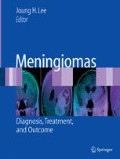In 1614, Felix Plater, Professor of Medicine, issued a case report from the University of Basel:1 Caspar Bonecurtius, a noble knight, began to lose his mind gradually over a two year period, to such an extent that finally he was completely stupefied and did nothing rationally. He had no desire for food and ate only when forcibly fed. … Finally after matters had gone on thus for six months, he died.
Access this chapter
Tax calculation will be finalised at checkout
Purchases are for personal use only
Preview
Unable to display preview. Download preview PDF.
References
Plater F. Observationum in hominis affectibus plerisque, corpori et animo, functionum laesione, dolore, aliave, molestia et vitio incommodantibus, libri tres. Ludovici Konig, 1614.
Cushing H. The meningiomas (dural endotheliomas): their source and favored seats of origin (Cavendish Lecture). Brain. 1922;45:282–316.
Czarnetzki A, Schwaderer E, Pusch CM. Fossil record of menin-gioma. Lancet. 2003;362:408.
Jonsdottir B, Ortner DJ, Frohlich B. Probable destructive menin-gioma in an archaeological adult male skull from Alaska. Am J Phys Anthropol. 2003;122:232–239.
Ortner DJ, Putschar WGJ. Identification of Pathological Conditions in Human Skeletal Remains. Washington, DC: Smithsonian Institution Press, 1985.
Anderson T. An example of meningiomatous hyperostosis from medieval Rochester. Med Hist. 1992;36:207–213.
Pacchioni A. Dissertatio epistolaris ad Lucam Schroeckium de glandulis conglobatis durae meningis humanae. Francesco Buagni, 1705.
Rainey G. On the gangliotic character of the arachnoid membrane of the brain and spinal marrow. Med Chir Trans. 1846;29:85–102.
Luschka H. Ueber das Wesen der Pacchionischen Drusen. Arch Anat Physiol (Berlin). 1852;19:101–114.
Meyer L. Die Epithelsgranulationen der Arachnoidea. Virchows Arch. 1859;17:209–227.
Cleland J. Description of two tumors adherent to the deep surface of the dura mater. Glasgow Med J. 1864;11:148–159.
Robin C. Researches anatomiques sur l' epithelioma des sereuses. J Anat (Paris). 1869;6:239–288.
Schmidt M. Uber die pachionischen Granulationen und ihr Verhältnis zu den Sarcomen und Psammomen der Dura Mater. Virchows Arch. 1902;170:429–469.
Learmonth JR. On leptomeningiomas (endotheliomas) of the spinal cord. Br J Surg. 1927;14:396–476.
Oberling C. Les tumeurs des meninges. Bull Assoc Franc Cancer. 1922;11:365–394.
Ribbert MW. Uber das endotheliom der dura. Virchows Arch. 1910;200:141–151.
Cushing H, Weed LH. Studies on the cerebrospinal fluid and its pathway. IX. Calcarious and ossseous deposits in the arachnoi-dea. Johns Hopkins Hosp Bull. 1915;26:372.
Bailey P, Bucy PC. The origin and nature of meningeal tumors. Am J Cancer. 1931;15:15–54.
Salzmann J. Exostosis seu excrescentia cranii osseo-spongiosa. Acta Physico-Medica Academiae Caesareae Leopoldino-Carolinae Naturae Curiosum exhibentia Ephemerides sive Observationes Historias et experimenta a Celeberrimis Germaniae et exterarum regionum viris habita & communicate. 1730;2:225–228.
Louis A. Sur les Tumeurs fongueses de la Dure-mere. Mem Acad Roy Chirurg. 1774;5:1–59.
Al-Rodhan NR, Laws ER. Meningioma: a historical study of the tumor and its surgical management. Neurosurgery. 1990;26: 832–846.
Bright R. Reports of medical cases, symptoms and morbid anatomy. In: Bright R, ed. Diseases of the Brain and Nervous System, vol II, part I. London: Longman, 1831:342–347.
Pecchioli Z. Storia di un fungo della dura madre operato coll'estirpazione dal professore Zanobi Pecchioli. Nuovo Giorn dei Letterati-Scienze, Pisa. 1838;36:39–44.
Lebert H. Ueber Krebs und die mit Krebs verwechselten Geshwulste im Gehirn und seinen Hullen. Virchows Arch. 1851;3:462–569.
Cushing H, Eisenhardt L. Menigiomas: Their Classification, Regional Behaviour, Life History, and Surgical End Results. Springfield, IL: Charles C Thomas, 1938.
Durante F. Contribution to endocranial surgery. Lancet. 1887;2:654–655.
Engert F. Ueber Geschwulste der Dura Mater. Virchows Arch. 1900;160:19–32.
Bailey P, Buchanan DN, Bucy PC. Intracranial Tumors of Infancy and Childhood. Chicago: University of Chicago Press, 1939.
Kleihues P, Cavanee WK. Pathology and Genetics of Tumours of the Nervous System. Lyon: IARC Press, 2000.
Cruveilhier J. L'Anatomie pathologique du Corps humain. Paris: J.B. Baillière, 1829.
Al-Rodhan NR, Laws ER. The history of intracranial menin-giomas. In: Al-Mefty O, ed. Meningiomas. New York: Raven Press, 1991.
Acrel O. Chirurgiska Handelser. Stockholm: H. Fought, 1775.
Guidetti B, Giuffre R, Valente V. Italian contribution to the origin of neurosurgery. Surg Neurol. 1983;20:335–346.
Jennett B. Sir William Macewen 1848–1924. Pioneer Scottish neurosurgeon. Surg Neurol. 1976;6:57–60.
Macewen W. Intracranial lesions, illustrating some points in connection with the localization of cerebral affections and the advantages of antiseptic trephining (III. Tumor of the dura mater). Lancet. 1881;2:581–582.
Guidetti B. Francesco Durante. June 29, 1844 to October 2, 1934. Surg Neurol. 1983;20:1–3.
Weir B. The American centennial of brain tumor surgery. Neuro-surgery. 1988;22:986–993.
Stone JL. W. W. Keen: America's pioneer neurological surgeon. Neurosurgery. 1985;17:997–1010.
Bingham WF. W. W. Keen and the dawn of American neurosur-gery. J Neurosurg. 1986;64:705–712.
Horwitz NH. Library: historical perspective. Herbert Olivecrona (1891–1980). Neurosurgery. 1998;43:974–978.
Ljunggren B. The case of General Wood. J Neurosurg. 1982;56:471–474.
Weber J, Spring A, Czarnetzki A. [Parasagittal meningioma in a skull dated 32500 years before present from southwestern Germany]. Dtsch Med Wochenschr. 2002;127:2757–2760.
Moodie RL. Studies in paleopathology XVIII. Tumors of the head among pre-Columbian Peruvians. Ann Med Hist. 1926;8: 394–412.
MacCurdy GC. Human skeletal remains from the highlands of Peru. Am J Phys Anthropol. 1923;6:217–330.
Abbott KH, Courville CB. Historical notes on the meningiomas. I. A study of the hyperostoses in prehistoric skulls. Bull Los Angeles Neurol Soc. 1939;4:101–113.
Lambert R. Meningiomas in Pharaoh's people. Br J Surg. 1949;36:423–424.
Brothwell D. The evidence for neoplasms. In: Brothwell D, Sandison AT, eds. Diseases in Antiquity. Springfield, IL: Charles C Thomas, 1967:320–345.
Author information
Authors and Affiliations
Editor information
Editors and Affiliations
Rights and permissions
Copyright information
© 2009 Springer-Verlag London Limited
About this chapter
Cite this chapter
Okonkwo, D.O., Laws, E.R. (2009). Meningiomas: Historical Perspective. In: Lee, J.H. (eds) Meningiomas. Springer, London. https://doi.org/10.1007/978-1-84628-784-8_1
Download citation
DOI: https://doi.org/10.1007/978-1-84628-784-8_1
Publisher Name: Springer, London
Print ISBN: 978-1-84882-910-7
Online ISBN: 978-1-84628-784-8
eBook Packages: MedicineMedicine (R0)

